|
With 1,700 years of Buddhist history, Korea is home to
numerous temples scattered around the nation that
preserve a rich, ancient heritage of Buddhist culture.
Each temple has its own interesting history as well as
a variety of Buddhist statues, paintings, pagodas, bells,
and other valuable cultural relics.
Korean Buddhist temples are often nestled deep in mountainous regions, and set near the natural beauty of rivers, valleys, or the sea. Their locations offer a great refuge for those seeking peace of mind or a quiet place to meditate. Temples also serve as residences for monks and devotees who practice or share the teachings of Buddha. Recently, a growing number of temples have developed temple stay programs for meditation, rest, or just to experience temple life, drawing increasing numbers of visitors every year.
Each temple is unique in its own way. Some of the major temples are: Tongdosa Temple and Beopheungsa Temple where sarira (relics of the Buddha) are kept; Haeinsa Temple, depository of the Goryeo Daejanggyeong (Tripitaka Koreana wooden printing blocks) which are on UNESCO’s Memory of the World list; Bongeunsa Temple and Hwagyesa Temple, well-known for temple stay programs; and Baekdamsa Temple and Naksansa Temple with their splendid natural landscapes. |
Below, temples are grouped by geographical location and major features are briefly described. | 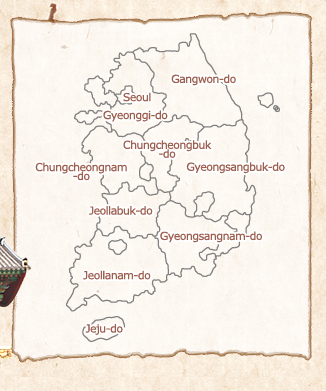 |
|
| Seoul |
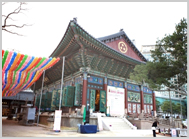
 Jogyesa Temple (조계사) Jogyesa Temple (조계사) Located in Jongno-gu in the heart of Seoul, Jogyesa Temple is home to the administrative headquarters of the Jogye Order of Korean Buddhism. Along with the streets of Insa-dong and the Gyeongbokgung and Changdeokgung palaces, Jogyesa is part of the traditional cultural district in downtown Seoul often visited by international tourists. The 500-year-old locust tree in the temple courtyard is 4 meters around and 26 meters high and has been designated an officially protected tree by the Seoul Metropolitan City government.
|
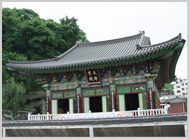
 Myogaksa Temple (묘각사) Myogaksa Temple (묘각사)Situated at the foot of Mt. Naksan in downtown Seoul, Myogaksa Temple was built by the monk Ven. Taeheo in 1930. The temple’s location was chosen according to geomancy (Feng Shui), which predicted a temple at that location would bring peace to the city. Its location does provide visitors wonderful views of Seoul’s busy Sungin-dong district from the sanctuary of the temple.
|
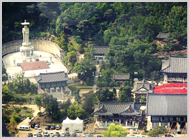
 Bongeunsa Temple (봉은사) Bongeunsa Temple (봉은사)Bongeunsa is a traditional temple situated among the high-rises of Samseong-dong in the Gangnam-gu district of Seoul. The Daeungjeon Hall, Mireukdaebul statue, and surrounding groves give the feel of a mountain temple in the bustling city. On average, approximately 10,000 devotees and 300 overseas tourists visit the temple daily.
|
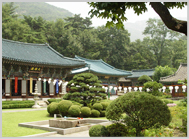
 Jingwansa Temple (진관사) Jingwansa Temple (진관사) Jingwansa is a renowned temple that is located four kilometers away from Yeonsinnae, a commercial center in northwest Seoul. Along with Buramsa Temple to the east, Sammaksa Temple in the south and Seunggasa Temple to the north, Jingwansa makes up what are considered the four major temples in Seoul’s suburbs. In 2009, relics from the Independence Movement were found during repair work at Chilseongjeon Hall of this temple, and research has since been ongoing.
|
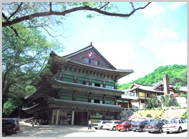
 Hwagyesa Temple (화계사) Hwagyesa Temple (화계사) Located on Mount Samgaksan in Seoul, Hwagyesa Temple was formerly the Bodeogam Hermitage in Buheo-dong on Mount Bukhansan until it was moved to its current location in 1522. The temple became well-known after the monk Ven. Sungsan traveled the world and trained over 50,000 foreign disciples. Today, the temple is still visited by numerous monks who come from all over the world to practice here. Hwagyesa offers a popular temple stay for international visitors and English teachings of the Buddha (dharma talks) on Sundays.
|
| |
|
| Gyeonggi-do Province |
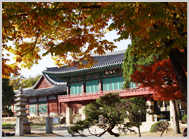
 Yongjusa Temple (용주사) Yongjusa Temple (용주사) Yongjusa Temple was built in 1790 by King Jeongjo (22nd monarch of the Joseon Dynasty, 1752-1800) in memory of his father Sado Seja (Prince Sado). On exhibit at the temple are cultural assets related to King Jeongjo. The Hubultaenghwa Buddhist painting behind the Buddhist statues in the Daeungjeon Hall is said to be the work of Kim Hong-do (1706-?), a famed artist of the latter part of the Joseon Dynasty. The wall around the temple and surrounding forest give the temple a cozy ambience.
|
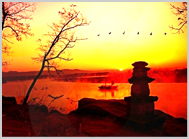
 Silleuksa Temple (신륵사) Silleuksa Temple (신륵사) Situated near a river, Silleuksa Temple is often wreathed in a layer of fog in the morning and offers beautiful evening sunsets. The temple is known as the first of the Eight Scenic Wonders of Yeoju (Yeoju Palgyeong) and is also associated with a number of legends regarding its name. It is home to many of Korea’s cultural assets, including Josadang Hall and the Dacheungjeontap (multi-story stone tower).
|
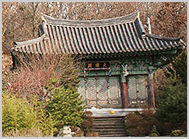
 Lotus Lantern International Meditation Center (연등국제선원) Lotus Lantern International Meditation Center (연등국제선원)The center was built by the monk Ven. Wonmyeong (1950-2003) in 1997 to commemorate the 10th anniversary of the Lotus Lantern International Buddhist Temple. Wonmyeong dedicated himself to teaching Buddhism to foreigners. The temple is on Ganghwa-do (Ganghwa Island) near Seoul and is a practice center and residence for monks from around the world. It offers popular temple stay programs, including the weekend temple stay experience, retreat program, and a 45-day & 4-night intensive meditation program.
|
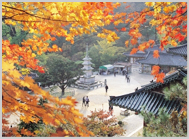
 Yongmunsa Temple (용문사) Yongmunsa Temple (용문사) Yongmunsa Temple is most famous for having the tallest gingko tree in Asia. Designated as Natural Monument No. 30, the tree is 1,100 years old and 62 meters tall. The temple itself dates back 1,000 years but does not have any of the original structures. As the base of resistance fighters at the end of the Joseon Dynasty, it was destroyed by the Japanese army in 1907 and again during the Yongmunsan Battle of the Korean War. The temple has been rebuilt to its present state through Buddhist donations. ☞ Yongmunsa Temple Stay – In Search of A Peace of Mind
|
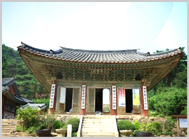
 Jeondeungsa Temple (전등사) Jeondeungsa Temple (전등사)Jeondeungsa Temple is situated on a mountain on Ganghwa-do (Ganghwa Island). The temple is encompassed by Samnangseong Fortress limiting access to through the fortress. The temple is said to date to 381, which would make it the oldest temple in Korea. Surviving through the Goryeo and Joseon dynasties, Jeondeungsa has been a significant landmark in both Korean politics and culture. Its complex includes a number of cultural assets, including Daeungbojeon and Yaksajeon halls.
|
| |
|
| Gangwon-do Province |
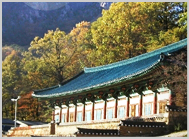
 Sinheungsa Temple (신흥사) Sinheungsa Temple (신흥사)In the fall, the splendid autumn foliage of Mt. Seoraksan draws a large number of visitors from around the nation. Built in 652, Sinheungsa Temple has been the symbolic guardian of Mt. Seoraksan. The temple has Geungnakbojeon, built in 1647 and the Tongildaebul Statue, which is 14.6 meters high. It also offers a picturesque view of Oeseorak (the area around Seorak Mountain).
|
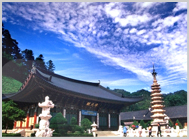
 Woljeongsa Temple (월정사) Woljeongsa Temple (월정사)Located on Mt. Odaesan, about two hours by car from Seoul, Woljeongsa Temple was built by the monk Jajang Yulsa (590?-658?) in 643. The temple is famous for the beautiful walk along its fir tree road. The 9-kilometer trail from Woljeongsa to Sangwonsa allows visitors to fully enjoy the surrounding natural scenery. The Palgakgucheungseoktap (octagonal nine-story stone pagoda) is the highlight of the cultural assets found in Woljeongsa temple. In front of the pagoda is a stone Buddha statue bowing toward the pagoda with hands clasped together.
|
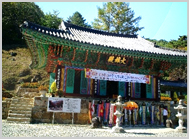
 Guryongsa Temple (구룡사) Guryongsa Temple (구룡사) According to legend, the site of Guryongsa Temple at the foot of Mt. Chiaksan was a pond which was home to nine dragons. The dragons disturbed construction work when the monk Uisang (625-702) started to build the temple, so he fought the dragons by using a talisman to heat the pond’s water. After completing the temple in 668, the monk named it Guryongsa (Temple of the Nine Dragons). The temple is home to Bogwangru Pavilion, a tangible cultural asset of Gangwon-do. An additional unique feature is Sansingak Hall, in which the tablets of the guardian mountain gods are kept.
|
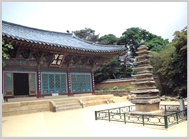
 Naksansa Temple (낙산사) Naksansa Temple (낙산사) Naksansa Temple sits at the foot of a beautiful pine-covered mountain near the East Sea. Naksan is the shortened name for the Sanskrit word botarakgasan, which means the place where the Buddha always resides. Since ancient times, Naksan has been revered by Buddhists as one of the Eight Scenic Beauties of Korea’s eastern region. The most popular spots in the temple are Haesugwaneumsang Statue overlooking the East sea, sunrise views from Uisangdae Pavilion, and Hongnyeonam Hermitage which sits on a cliff overlooking the sea.
|
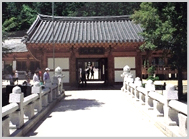
 Baekdamsa Temple (백담사) Baekdamsa Temple (백담사) Located deep in Naeseorak (Inner Seorak Mountain), Baekdamsa Temple is most splendid in late fall when it is covered with striking crimson colors. It is well known as the temple where Manhae Han Yong-un (1879~1944), a famous activist of the Independence Movement, became a monk. The Manhae Memorial Hall contains an exhibit including 800 personal items of Han Yong-un. ☞ Mt. Seoraksan National Park
|
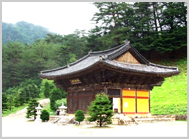
 Beopheungsa Temple (법흥사) Beopheungsa Temple (법흥사)Jeongmyeolbogung refers to the temples where the Buddha’s sarira (relics) are kept. In Korea, the five major Jeongmyeolbogung are Sangwonsa in Mount Odaesan, Jeongamsa in Mount Taebaeksan, Tongdosa in Mount Yeongchuksan, Bongjeongam in Mount Seoraksan, and Beopeungsa. These temples do not have Buddha statues as they keep Buddha’s sarira. Behind Beopeunsa Temple are a cave and sarira tower where the monk Ven. Jajang Yulsa (590?-658?) is said to have meditated and kept the sarira.
|
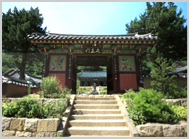
 Samhwasa Temple (삼화사) Samhwasa Temple (삼화사)Located at the foot of Mount Dutasan, Samhwasa Temple has several legends associated with its construction. Many believe the monk Ven. Jajang Yulsa (590-658) built the temple in 642 and originally named it Heungnyeondae. Its current name was given during the reign of Taejo Wang Geon who opened the era of the Goryeo Dynasy (918-1392) after unifying the Three Kingdoms. The temple contains two major cultural assets; the Cheolbul iron statue created between the 7th and 9th centuries and a three-story stone pagoda built in the mid 9th century.
|
| |
|
| Chungcheong-do Province |
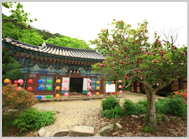
 Magoksa Temple (마곡사) Magoksa Temple (마곡사)According to Taengniji (an old geographical document) and the prophetic writings in Jeonggamnok, Magoksa Temple's location is one of the safest places in times of war. It is known for its beautiful natural scenery year round. The temple is nestled deep in a valley and has several cultural assets including the Yeongsanjeon Hall(longest surviving hall in the temple), and a five-story stone pagoda that was influenced by Tibetan Buddhism. ☞ Gongju, the Glory of Baekje Lives On
|
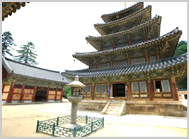
 Beopjusa Temple (법주사) Beopjusa Temple (법주사)Located at the foot of Mt. Songnisan, Beopjusa Temple was built in 553 by the monk Ven. Uisin. Legend has it that upon returning from India, the monk set out to find a site for a temple. He rode on a white donkey carrying Buddhist texts. As he approached the current site of the temple, the donkey stopped, refusing to go any further. Uisin built a temple at the site and called it Beopjusa, meaning 'where Buddha's teachings remain.' The temple's highlights include Geumdongmireukdaebul (gilded bronze Buddha statue 33 meters high), Palsangjeon(five-story wooden pagoda), Daeungbojeon (considered one of Korea's three major Buddhist halls), and Ssangsajaseokdeung (two-lion stone lamp). ☞ Two-day Tours in Chungcheongbuk-do Province
|
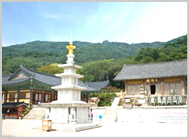
 Sudeoksa Temple (수덕사) Sudeoksa Temple (수덕사) Scholars believe Sudeoksa Temple was built sometime during the four decade reign of King Wideogwang of Baekje (554 to 598). More famous for the nearby Sudeongnyeogwan Inn, Sudeoksa was the residence of Great Monk Gyeongheo (1849-1912), who revived Seonjong Buddhism in the late Joseon Dynasty, and the monk Ven. Mangong (1871-1946), one of Gyeongheo's disciples who rebuilt the temple and trained many others. The temple is also known as the place where the monk Ven. Iryeop (1896-1971), who was a famous female writer before entering the Buddhist priesthood, had practiced.
|
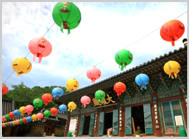
 Gapsa Temple (갑사) Gapsa Temple (갑사)Located on the foot of Mount Gyeryongsan in the northwest, Gapsa is a popular temple that is easy to access from the nearby downtown area. The temple is most beautiful in the fall. Its construction (6C-7C) was largely overseen by the monk Uisang (625-702). There are many cultural assets, including the Cheoldanggan (iron flag pole) and its pillars, the wood printing block of Worinseokbo, and the Gwaebultaenghwa Buddhist painting. ☞ Gongju, the Glory of Baekje Lives On
|
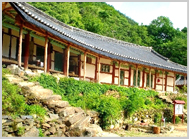
 Buseoksa Temple (부석사) Buseoksa Temple (부석사) There are two famous temples with the name Buseoksa in Korea. One is in Seosan, Chungcheongnam-do, and the other in Yeongju, Gyeongsangbuk-do. The one in Seosan is not big in size but is known as the temple where the historically renowned monk Ven. Gyeongheo (1849-1912) and monk Ven. Mangong (1871-1946) practiced. The west coast adjacent to the temple is a sanctuary for various migratory birds.
☞ Nirvana Revealed : Buseoksa Temple
|
| |
|
| Gyeongsang-do Province |
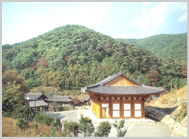
 Gounsa Temple (고운사) Gounsa Temple (고운사)Gounsa Temple is elegant and tranquil. Built in 681 by the monk Ven. Uisang (625-702), the temple features taekgeuk patterns and dancheong coloring in Yeonsujeon Hall. The temple seen from Nahanjeon Hall offers picturesque views and the wall painting of a tiger whose eyes follow those of the viewer often fascinates visitors.
|
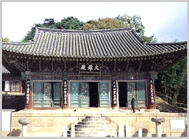
 Donghwasa Temple (동화사) Donghwasa Temple (동화사) Donghwasa Temple is situated at the southern foot of Mt. Palgongsan, a prominent peak of Daegu. The temple was built as Yugasa Temple in 493 by the monk Ven. Geukdal and its name was later changed to Donghwasa. The temple has preserved numerous cultural assets throughout its long history, one of which is the 17-meter tall Tongillyaksayeoraedaebul Buddha statue erected in 1992.
|
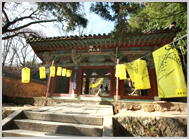
 Beomeosa Temple (범어사) Beomeosa Temple (범어사) Busan, where Beomeosa Temple is located, went unscathed from much of the destruction during the Korean War (1950-1953). During the war, the temple was frequented for prayers and meditation by devotees from across the country. For this reason, many monks carry on the tradition of pilgrimage and indoctrination education at this temple. This is also why Busan has a large number of Buddhist followers. Built in 678, it has been rebuilt many times over the centuries. Together with Haeinsa and Tongdosa, Beomeosa is one of three major temples in Gyeongsang-do province. ☞ Busan
|
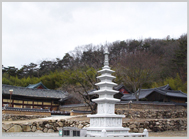
 Eunhaesa Temple (은해사) Eunhaesa Temple (은해사) Situated in the southern part of Mt. Palgongsan, Eunhaesa Temple was built by Hyecheol Guksa (785-861) in 809 below the current site of Unbuam Hermitage. Its original name was Haeansa. The temple was destroyed in a fire in 1545 and was rebuilt the following year in its current location under the name Eunhaesa, meaning 'land of happiness above a silver sea.' Nearby are the Unbuam and Baekeungam hermitages. Also, a work by noted Joseon Dynaasty calligrapher Kim, Jeong-hee (1786-1856 - aka Chusa) hangs in the main hall.
|
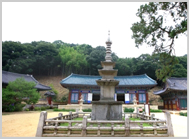
 Jikjisa Temple (직지사) Jikjisa Temple (직지사) Located in Gimcheon (midway between Seoul and Busan), Jikjisa Temple can be accessed easily by travelling from Seoul by train and connecting to buses that run frequently between Gimcheon station and the temple. Built by the monk Ven. Ado in 418, Jikjisa Temple once rose to great power, even owning areas of Gimcheon city during the Joseon era (1392-1910). The temple is surrounded by a thick forest and entrance is by way of an adjacent park. An old wives tale has it that a woman will bear a male child if she lays her eyes on the baby Buddha immediately upon entering Birojeon Hall.
|
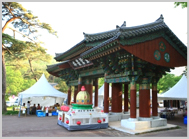
 Tongdosa Temple (통도사) Tongdosa Temple (통도사)Built by Jajang Yulsa (590-658) in 646, Tongdosa is known for keeping Buddha's sarira. When returning from the Tang Dynasty, Jajang Yulsa brought with him part of Buddha's sarira and robe and enshrined them in the temple. The temple is nestled among trees and valleys, and the buildings lining the way from Iljumun Gate to Daeungjeon have an old and unique feel. There are also a number of hermitages in the valleys. ☞ Tranquility of Tongdosa
|
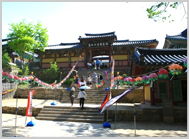
 Haeinsa Temple (해인사) Haeinsa Temple (해인사) Built in 802 by the monks Ven. Suneung and Ven. Ijeong, Heinsa Temple was designated as a national temple in the Goryeo Dynasty (918-1392). During the Joseon Dynasty (1392-1910), it was the depository of Goryeo Daejanggyeong (Tripitaka Koreana wooden printing blocks), which are now listed in the UNESCO Memory of the World program. Haeinsa is a general temple offering meditation, Buddhist text education, and education in the principles of Buddhism. ☞ Haeinsa temple stay
|
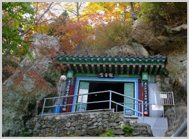
 Golgulsa Temple (골굴사) Golgulsa Temple (골굴사)Golgulsa is a unique cave temple whose date of establishment is unknown. Twelve rock caves line a narrow, steep stairway, leading up to the sculpture of the Maya Tathagata Buddha carved in a limestone cliff. After a long and arduous climb, visitors are rewarded with splendid views from the Maya Tathagata Buddha. As the headquarter of Zen Buddhist martial arts in Korea, the temple is sometimes referred to as the Shaolin Temple of Korea. It is also famous for its temple stay program.
|
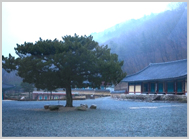
 Girimsa Temple (기림사) Girimsa Temple (기림사) Situated deep in Mount Hamwolsan, Girimsa Temple was built by Indian monk Ven. Gwangyu in 643 under the name Imjeongsa and was later changed to Girimsa by monk Ven. Wonhyo (617-686). It is largely divided into three sections: the Daejeokgwangjeon area with the Vairocana Buddha; the Samcheonbuljeon Hall with its 3,000 buddhas; and the Seongbo Museum with Geonchilbosaljwasang (a seated Buddha). The temple is a great destination for those seeking a relaxing environment as it is surrounded by a forest with valleys, waterfalls, and nearby fields of green tea and lotus flowers. ☞ Best Gyeongju 3Night/4Days Course
|
| |
|
| Jeolla-do Province |
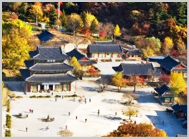
 Geumsansa Temple (금산사) Geumsansa Temple (금산사) Geumsansa Temple is quietly nestled at the foot of Mt. Moaksan, where a number of native religions originated. It was built in 599 in honor of the king. In 766, it was rebuilt by monk Ven. Jinpyo (718-752) as a maitreya meditation center. The temple‘s cultural assets include the Mireukjeon Hall (the only three-story hall in Korea), where the Mireuk Samjonbul statues are kept.
|
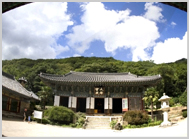
 Daeheungsa Temple (대흥사) Daeheungsa Temple (대흥사) Located in Mt. Duryusan at the southernmost end of Korea, Daeheungsa (also called Daedunsa) emerged as a major Buddhist temple after enshrining the mementos of the monk Ven. Seosan (1520-1604). At the time, Seosan stated that Duryusan was an ideal location to promote the teachings of Buddha. He requested his baru dish and monk robe be kept there. Following his death, numerous monks have followed in his footsteps. The temple’s grand size accommodates many halls and also has Mireugam and Iljiam hermitages nearby. The top of Mt. Duryusan offers an impressive view of the southern sea. ☞ Namdo Getaway: Experiencing the Beauty of Haenam and Jindo
|
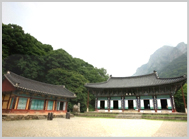
 Baegyangsa Temple (백양사) Baegyangsa Temple (백양사) The temple was built by the monk Ven. Yeohwan in 632 as Baegamsa, and its name changed to Baegyangsa in the late 19th century. As a center for Zen Buddhist meditation, many esteemed monks originate from this temple. The hermitages of Unmunam and Unmunseonwon were popular as leading meditation centers for the lands south of the Hangang River. The temple serves as a general practice center with centers for meditation, Buddhist education, and Buddhist discipline studies. The autumn foliage is particularly striking, and a great view of the temple can be seen from Yaksaam Hermitage.
|
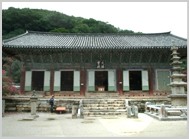
 Seonunsa Temple (선운사) Seonunsa Temple (선운사) Seonunsa Temple is busiest in March and April when camellia flowers are in full bloom. The temple was built by the monk Ven. Geomdan in 577 and flourished in the late Joseon Dynasty (1392-1910), when it had 189 halls and 89 hermitages. Today, only 13 halls remain against a backdrop of camellia groves. Visitors are recommended to visit Dosoram Hermitage for great views of Mt. Dosolsan.
|
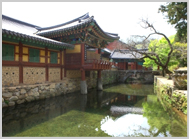
 Songgwangsa Temple (송광사) Songgwangsa Temple (송광사)Built by the monk Ven. Hyerin in the end of the Silla Kingdom (57BC-935AD), Songgwangsa Temple was largely destroyed in the Korean War (1950-1953). The rebuilding work launched in the 1960s restored most of the buildings. The temple is a general Buddhist practice center of the Jogye Order. Even before temple stay programs became popular, Songgwangsa Temple was well received for a style that strictly follows Buddhist traditions. ☞ Wonders of nature: Incredible Biodiversity at Suncheonman Bay!
|
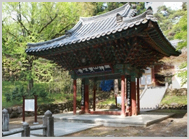
 Ssanggyesa Temple (쌍계사) Ssanggyesa Temple (쌍계사)The four-kilometer long cherry tree road from Hwagaejangteo market to Ssanggyesa Temple in Mt. Jirisan is very beautiful. Built by the monks Ven. Daebi and Ven. Sambeop in 722, the temple is well known as the origin of Beompae Buddhist ceremonial music and many practicing artists. In the early 9th century, Great Monk Ven. Jingam Guksa (774-850) created green tea fields on Mount Jirisan. The area has since been known for producing traditional green tea. ☞ The Hadong Wild Tea Cultural Festival: Working at a Green Tea Plantation
|
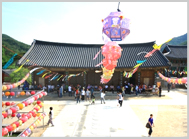
 Hwaeomsa Temple (화엄사) Hwaeomsa Temple (화엄사) Located where the beautiful scenery of Mt. Jirisan and the clear waters of Seomjiingang River meet, Hwaeomsa was built in 544 by the monk Ven. Yeongi. With over 1,500 years of history, the temple has a collection of many of Korea's cultural assets. Most of the halls are clustered around the main yard, giving the temple a cozy yet majestic ambience. The Gakwangjeon Hall and the stone pagodas and lanterns are works that depict the moral conduct of filial piety. The temple stay program is offered with varying themes depending on the season.
|
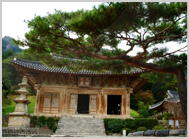
 Naesosa Temple (내소사) Naesosa Temple (내소사) Located in Byeonsan-bando Peninsula in the western end of Korea, Naesosa has the meaning of "So that all that enter be blessed and realize what they wish." The temple was built by the monk Ven. Hyegu in 633 and originally named Soraesa. The Daeungjeon Hall features fascinating architectural detail and is famous for its Baegui-gwaneumbosal-jwasang painting. ☞ Mountain High and Water Deep on the Byeonsan Peninsula
|
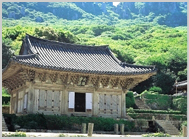
 Mihwangsa Temple (미황사) Mihwangsa Temple (미황사) Mihwangsa is a small temple situated in Ttangkkeut Maeul village in the southernmost region of Korean. The temple offers great views of Mt. Dalmasan and the southern sea. Built in 749, Mihwangsa Temple is also known for striking sunsets behind the mountain ridges of Dalmasan. A 10-minute walk along a short trail from the temple leads to Budojeon with stupas enshrining the sarira of esteemed monks. ☞ An Overnight Temple Stay at Mihwangsa Temple in Haenam
|
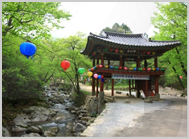
 Seonamsa Temple (선암사) Seonamsa Temple (선암사)Located in the east of Mount Jogyesan, Seonamsa is the leading temple for the Taego Order, which is the second largest order of Buddhism in Korea. Built in 529, the temple’s weathered buildings are surrounded by a cozy wall. The Seungseongyo rainbow bridge and the Gangseollu pavilion seen from beneath the bridge are great examples of the beauty of Korean architecture and are often used as filming locations. The spring football match between the monks of Seonamsa and Songgwangsa temples is a popular event that takes place in Suncheon. ☞ Seonamsa Temple
|
| |
|
| Jeju-do |
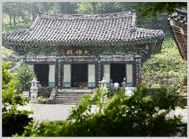
 Gwaneumsa Temple (관음사) Gwaneumsa Temple (관음사)Buddhism in Jeju evolved side by side with other native religions and unique influences from the volcanic island. Gwaneumsa Temple is the center of Buddhism in Jeju. Most of its buildings were destroyed by fire after the liberation of Korea in 1945. The temple was restored and has preserved its traditional look and magnificence befitting its 1,600 year history.
|
|











































댓글 없음:
댓글 쓰기